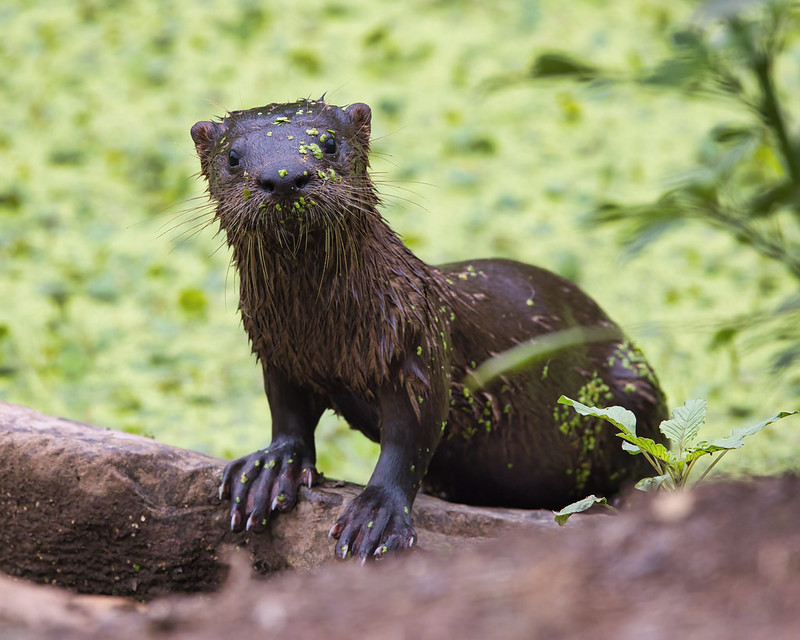During a recent visit to the Sequoyah National Wildlife Refuge in Oklahoma, I had the privilege of encountering a playful River Otter pup. Capturing this young otter with my camera allowed me to closely observe its fascinating adaptations, particularly its specialized feet, which are essential for thriving in an aquatic environment. The experience highlighted the remarkable features that make River Otters such skilled swimmers and hunters.

Webbed Feet: Masters of Aquatic Navigation
The webbed feet of River Otters are one of their most essential adaptations for life in the water. Covered in dense fur, these feet not only provide warmth but also act as natural paddles. The webbing between the toes increases surface area, offering greater propulsion and allowing the otter to glide effortlessly through the water. Observing the otter pup navigating the shallow waters was mesmerizing—it moved gracefully, propelled by its powerful, webbed feet.
Sharp Claws: Tools for Hunting and Navigation
In addition to webbed feet, River Otters possess sharp claws that are vital for hunting and survival. These claws help the otters grasp slippery prey, such as fish, with precision. The claws also assist in climbing onto rocks, navigating vegetation, and grasping objects along riverbanks. Watching the otter pup interact with its surroundings, it was clear that these claws provided not only hunting advantages but also helped in quickly maneuvering through various terrains.
Sensitive Pads: Detecting Underwater Movements
River Otters have highly sensitive pads on their feet, which play an essential role in detecting vibrations and movements of prey beneath the water’s surface. These pads help the otters locate and capture prey even in murky or low-visibility conditions. The pup I photographed demonstrated this remarkable ability as it foraged in the shallows, seemingly aware of every subtle disturbance in the water.
Furry Insulation: Keeping Warm in Cold Waters
The pads and toes of a River Otter are covered with dense fur, which provides insulation against cold water temperatures. This furry covering not only protects the otter’s feet from injury but also maintains its body heat while swimming in chilly rivers and streams. The otter’s fur, combined with its fat layer, enables it to stay active even in colder environments, making it a versatile and resilient species.
Sealing the Webbing: The Ultimate Swimming Adaptation
One of the most unique features of River Otter feet is the ability to seal the webbed skin between their toes, reducing drag while swimming. This adaptation allows the otter to optimize speed and maneuverability in the water, making it an exceptional swimmer capable of chasing down prey or escaping potential threats. Watching the pup quickly change direction and swim with ease showcased the effectiveness of this adaptation.
Technical Details of the Shot
To capture the playful otter pup, I used my Canon EOS R5 camera with a Canon RF 100-500mm F4.5-7.1 L IS USM lens. Here were the technical settings used:
- Date and Time: August 18, 2022, at 10:28 A.M.
- Exposure Mode: Manual
- Aperture: f/8.0
- Shutter Speed: 1/2500 sec
- ISO: 2500 (Auto)
- Exposure Compensation: +1/3
- Focal Length: 500mm
The fast shutter speed of 1/2500 sec allowed me to freeze the otter’s movements as it darted around. The aperture of f/8.0 provided enough depth of field to keep the entire animal in focus while softly blurring the background, helping the otter stand out in the image. The ISO setting of 2500 helped compensate for the fast shutter speed in the shaded area of the wetlands.
The River Otter’s Remarkable Adaptations
The North American River Otter’s feet are a testament to the wonders of evolutionary adaptation. Their webbed feet, sharp claws, sensitive pads, and ability to seal off the webbing between their toes all contribute to their extraordinary swimming and hunting skills. These adaptations enable the otter to move fluidly between land and water, making them efficient and versatile predators.
The playful behavior and specialized adaptations of the River Otter pup I observed at Sequoyah National Wildlife Refuge were a reminder of nature’s ingenuity. Each feature serves a purpose, allowing the otter to thrive in a variety of environments. Observing and photographing this young otter was a captivating experience, showcasing the incredible diversity and resilience of wildlife.
Tips for Photographing Wildlife Like River Otters
Capturing high-quality wildlife photos requires preparation, patience, and knowledge of the subject’s behavior. Here are a few tips for photographing otters or similar animals:
- Use a Telephoto Lens: A lens with at least 400mm reach is ideal for capturing detailed images without disturbing the animal.
- Shoot at High Shutter Speeds: Otters are fast and agile, so set a shutter speed of 1/1000 sec or faster to freeze their movement.
- Stay Low and Quiet: Approach slowly and use natural cover to avoid startling the otter. Position yourself at eye level for a more intimate shot.
- Consider Lighting Conditions: Early morning or late afternoon light provides the best natural illumination, enhancing the animal’s fur and surrounding environment.
- Observe Behavior: Understanding the otter’s habits can help predict its movements, increasing the chances of capturing unique behaviors.
Photographing the River Otter pup at Sequoyah National Wildlife Refuge was an enriching experience, allowing me to document the marvels of nature up close. Wildlife photography not only captures the beauty of the natural world but also helps raise awareness about the importance of protecting habitats where these remarkable creatures thrive.
